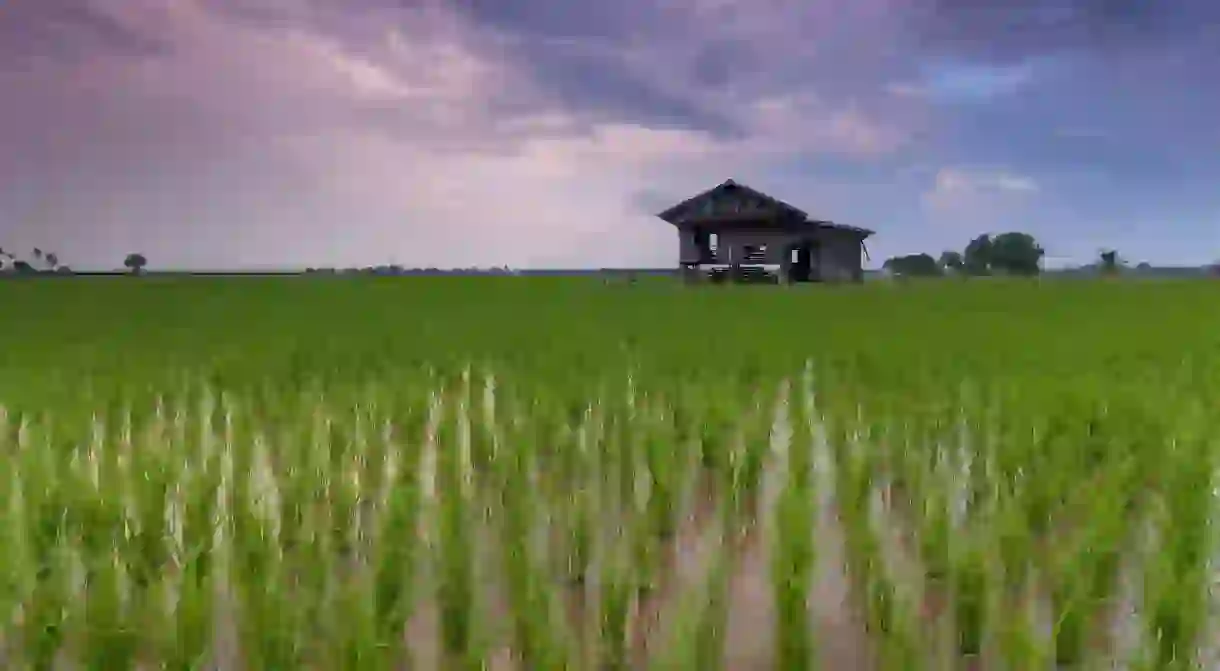How Cambodia Came to Produce Arguably the World's Best Rice

Rice is a staple in the Cambodian diet, whether it’s eaten for breakfast, dinner or a simple snack. Therefore, it comes as little surprise that the country grows some of the world’s finest rice.
Step out of the city and you’ll find evidence of Cambodians’ passion for rice everywhere. The countryside is a patchwork quilt of rice fields, with agriculture being one of the country’s main economic pillars (contributing at least 23 percent of its total gross domestic product).
The majority of rural families in Cambodia have small paddies, surrounding their wooden stilt houses that pepper the countryside. They grow enough rice to see their family through the year, storing the grains in homemade shelters.
These humble crops can be contrasted with large-scale farming for export and sale, involving years of rigorous testing to achieve the perfect grain. For the past three years, Cambodian rice has been internationally-recognised as the best rice on the planet.

The heavy monsoon rains that hammer the country periodically between May and October, coupled with the Mekong and Tonlé Sap rivers flooding, provide fertile soils for rice farming, a form of agriculture that Cambodians have been devoted to for thousands of years.
A history of Cambodia’s rice
According to the Cambodia Rice Federation, rice has been a staple crop in the country since before the rise of the Khmer Empire in the 9th century. It is estimated rice growing could date as far back as 5000 BC. In the book, 10 Main Rice Crops, written by Minister of Agriculture Chan Sarun in 2011, Sarun writes that rice has been a crop along the Tonlé Sap river since between 5000–2000 BC.
During the reign of the ancient Khmer Empire—the creators of Angkor Wat and other temples that dot the world-famous archaeological park—a series of elaborate systems were invented to irrigate the paddies. Moats and waterways were created to keep a constant flow of water for the rice. These innovations enabled up to four crops to be yielded annually, instead of just one.

Cambodians’ love of rice continued under French colonial rule. During the mid-19th century, stretches of the northwestern province of Battambang were transformed into large-scale rice farms for internal consumption as well as export. Today, Battambang wears the crown for being the ‘rice bowl’ of Cambodia.
As Cambodia’s weather became more unpredictable, then-Prince Norodom Sihanouk initiated various irrigation projects to improve the flow of water and increase the land’s fertility in more populated provinces, including Kampong Cham and Kandal. This mission led to a more than two-fold increase in the country’s yields, transforming Cambodia’s rice industry into what it is today.
Types of Cambodian rice
Rice is rice, right? Wrong. There are many different varieties, and Cambodia grows a wealth of them.
The majority of rice grown in the country can be split into two types: fragrant and white rice. Unmilled—rice that has only had the husk removed—white rice is what feeds the majority of families in Cambodia, and there are many varieties. Some grow best in the wet season and others in the dry season.
Milled—where the husk and bran layers are removed, leaving a pure grain—fragrant rice is mostly produced for export. The main crop is the country’s award-winning premium jasmine rice, which is grown during the wet season, renowned for its long grain, soft texture and strong scent and flavour. Varieties include Phka Rumdoul and Neang Malis.

Thousands of years of experience in rice cultivation has paid off for the country in recent years. Cambodia’s top-quality strains have secured successes in a string of international competitions. In 2012, 2013 and 2014, a fragrant Cambodian jasmine rice variety Phka Rumduol—often referred to as phka malis—was crowned the world’s finest rice by the International Commodity Institute at the annual World Rice Conference.
In 2015, it lost the title to a Californian strain, and the next year, a Thai brand from Chiang Mai secured the top spot. In 2017, the premium fragrant rice ranked among the top three strains, marginally missing out to Thailand’s Horm Malis rice. Hopes are high that Cambodia can win back the coveted title.
Recent troubles for Cambodia’s rice industry
Though the majority of villagers in Cambodia grow rice to feed their families or sell it locally, rice export is also big business in the country. However, the industry has seen trouble in recent years.
According to figures from the Ministry of Agriculture, in 2017, the country exported 635,679 tonnes of rice—17 percent more than the previous year. However, as of July 2018, 297,080 tonnes were exported—a 6.3 percent fall.

Unpredictable climates, price competition with neighbouring countries and limited storage capacity have been blamed for the industry’s tumbling growth.
Swathes of paddies across Cambodia took a battering in 2018. Many were swamped with floods after unusually heavy rains, plus the rush of water from a failed dam being built in the southeastern province of Champasak in Laos in July. In some areas, almost a third of total harvests were damaged.
Cambodian rice sold abroad
Despite these setbacks, Cambodia’s IBIS Rice has recently been flying off the shelves in wholesale markets across the world.
The premium organic jasmine strain is grown with an ethical slant, working with local farmers to provide them with a sustainable form of income. Profits are also ploughed into protecting 500,000 hectares of remote national parkland in Preah Vihear province—home to more than 60 endangered species, including Cambodia’s national bird the Giant Ibis.













